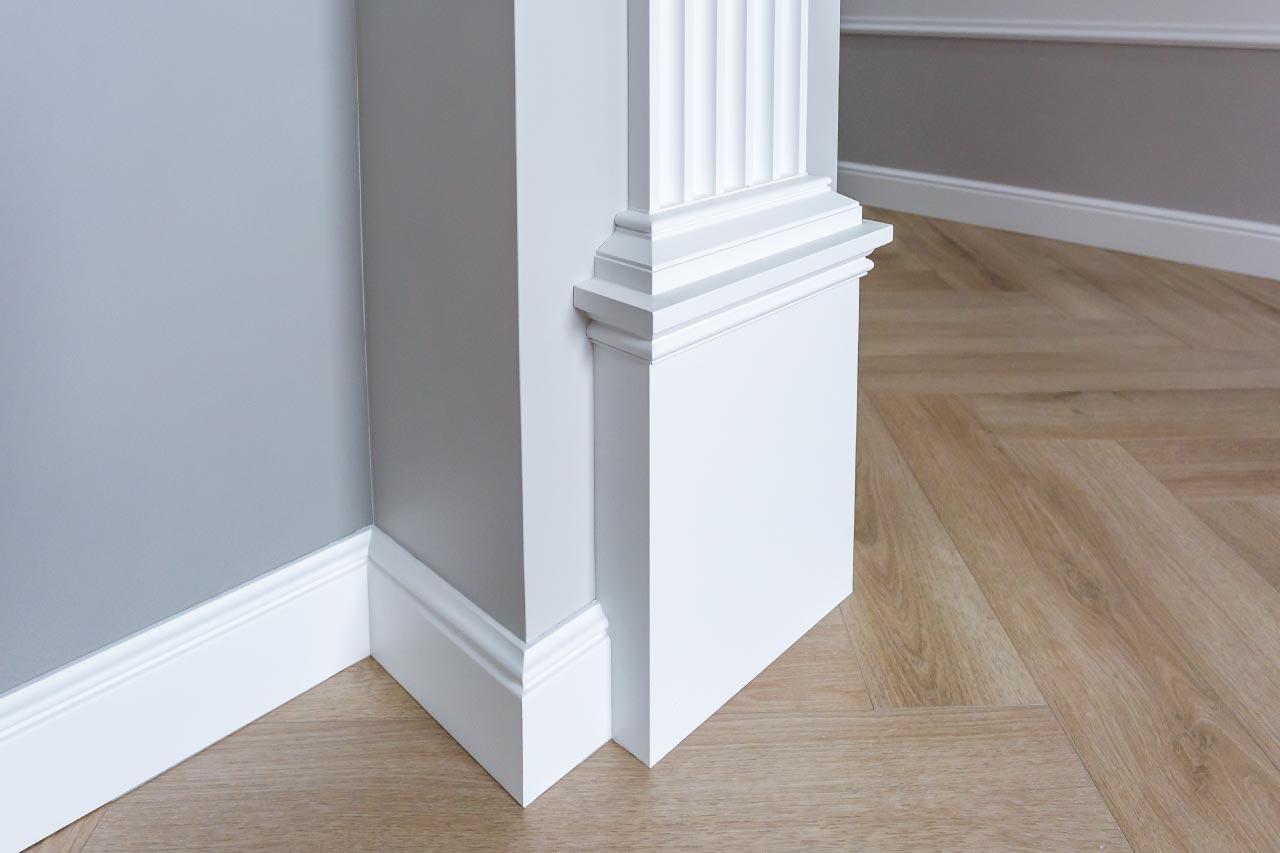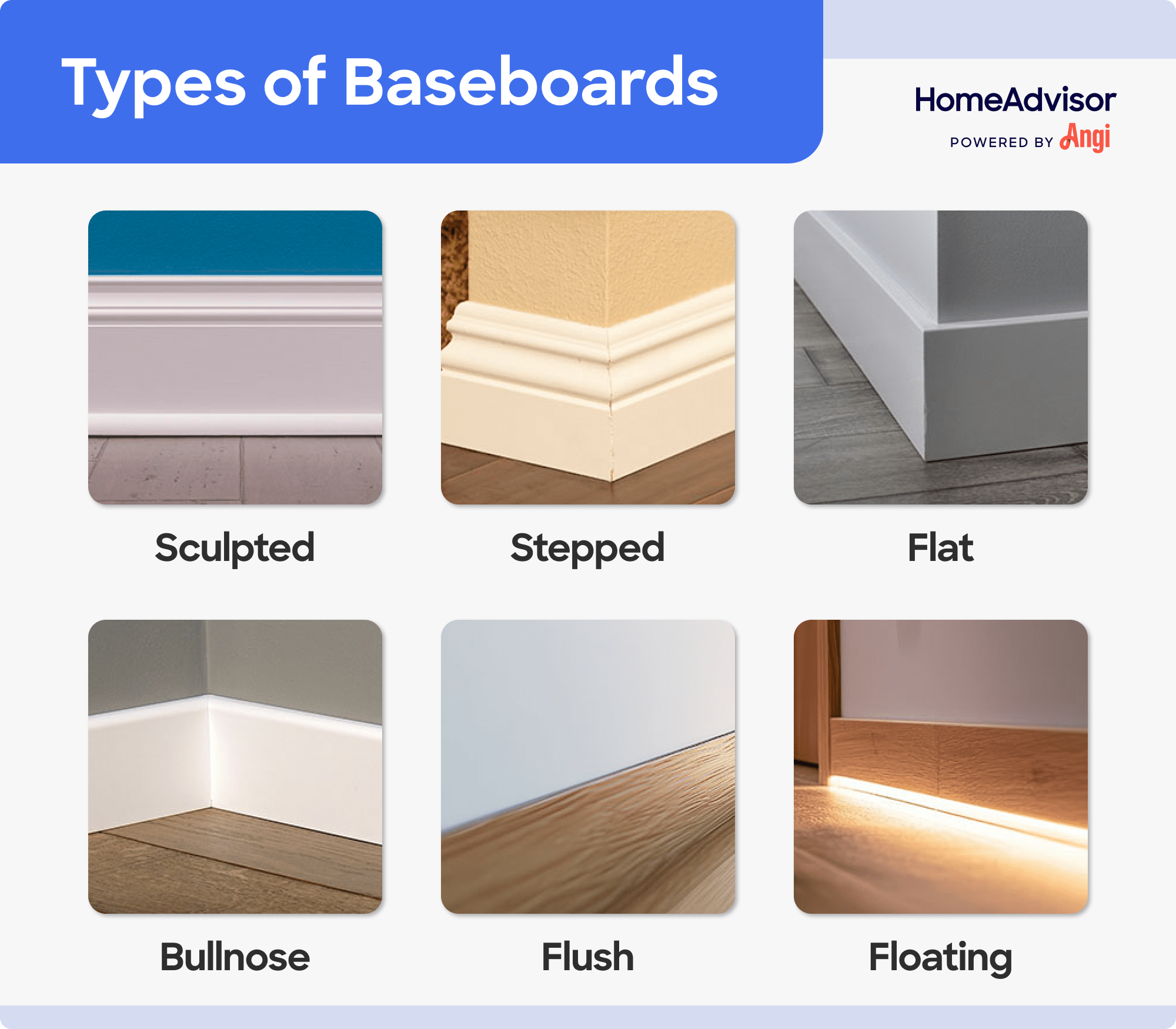
Budget for the cost of trim installation based on factors such as material, finishing, trim type, labor, project size, and more.
The cost to install baseboards is $1,100 on average but often ranges from $800 to $2,250. A pro can give you an accurate quote based on the style you want and how big your space is.


Baseboard installation costs $5.70 to $9.00 per linear foot, including materials and labor.
Costs vary based on area size, baseboard style, materials, labor, removal and disposal, painting, and floor and wall repairs.
Installing new baseboards enhances your home's appearance and can increase its value.
Hiring a professional ensures proper installation and helps avoid costly mistakes.
This article was created using automation technology and thoroughly fact-checked and edited by HomeAdvisor Editor Ryan Noonan.
Replacing the baseboards in your home not only enhances its overall appearance but also protects your walls from bumps and scrapes. On average, homeowners spend $1,100 on baseboard installation, but you could pay anywhere from $750 to $3,000. Costs vary based on factors like the size of the area, baseboard style, and material. Knowing what to expect can help you budget effectively and decide if hiring a professional is right for you.
Several factors influence the total cost of installing new baseboards, including the size of your space, the style and material of the baseboards, and labor costs. Understanding these can help you make informed decisions and plan your budget.
Contractors charge between $5.70 and $9.00 per linear foot for baseboard installation, which includes both materials and labor. The larger your space, the higher the overall cost. If you need old baseboards removed, you might also pay around $20 for debris removal services.

There are several different baseboard styles, each with a different shape. Simple types, such as shoe molding, cost less than more complex designs like base molding.
| Baseboard Style | Price Range per Linear Foot (All-In) | Average Cost per Linear Foot (All-In) |
|---|---|---|
| Shoe molding | $5.50–$8.50 | $7.00 |
| Quarter round molding | $5.50–$9.00 | $7.50 |
| Base molding | $5.50–$10.50 | $8.00 |
Choosing the right baseboard material is important for both aesthetics and durability. The main options are wood, medium-density fiberboard (MDF), and PVC. Wood baseboards offer a luxurious look and are easy to repair, though they are the most expensive. MDF is a budget-friendly alternative that's easy to install and maintain. PVC is the least expensive and resistant to moisture, but it's more prone to impact damage and harder to repair.
| Baseboard Material | Price Range per Foot |
|---|---|
| PVC | $0.90–$1.40 |
| MDF | $1.00–$1.40 |
| Wood | $1.40–$10.00 |
Labor costs for installing baseboards range from $5 to $7.75 per linear foot. This includes measuring, cutting, and securing the baseboards to ensure a precise fit and a professional finish.
Expect to pay between $50 and $100 per hour for labor to remove your existing baseboards. This often includes debris removal, but if not, you might need to budget an additional $20 for disposal services.
If your new baseboards are unfinished, you'll need to stain or paint them. On average, painting baseboards adds an extra $1 to $6 per linear foot. If you're considering painting other areas of your home, it might be more cost-effective to hire a local painter to handle the whole project.
During baseboard installation, contractors might discover issues with your walls or floors, such as moisture damage or uneven surfaces. If that's the case, you may need to replace drywall, which costs $2.40 to $4 per square foot, or address other wall repairs costing $360 to $1,240.
Similarly, if your flooring is damaged—like buckled or torn—you might consider fixing it before installing new baseboards. New flooring installation costs $3 to $22 per square foot, but repairing existing floors can save money, costing $200 to $580. While updating your baseboards, it's also a good opportunity to repair or replace trim in other areas to refresh the entire room.
If your baseboards have minor damage, like scuff marks or small scratches, you can often fix them yourself with a fresh coat of paint or by filling in holes with putty. These simple DIY repairs are inexpensive and work best on wood baseboards. Due to their composition, repairs may be more challenging for materials like PVC.
For more significant damage—such as from termites, water, or wear and tear—it might be time to replace the affected baseboards. Removal costs around $1.50 per linear foot, with installation of new baseboards adding $6 to $9 per linear foot. Since some contractors have a minimum service fee, it can be more cost-effective to replace multiple sections at once.
Installing new baseboards enhances the appearance of your home and protects your walls and floors. In fact, 97% of real estate professionals agree that new trim can increase a home's value. While the exact boost may vary, investing in new baseboards is a smart move that adds both aesthetic appeal and potential resale value.
Even though it's best to hire a local pro for baseboard installation, there are ways to keep your project budget-friendly:
Prepare your space: Clear out furniture and appliances. If you're planning to paint the baseboards, lay down drop cloths to protect your floors.
Remove old baseboards yourself: If you're comfortable with DIY tasks and confident you won't damage your walls, removing the old baseboards yourself can save on labor costs.
Buy materials in bulk: Updating baseboards in multiple rooms? Check for bulk discounts at hardware stores. Your contractor might also have access to special pricing.
Consider pre-finished baseboards: Pre-painted or pre-stained options can save time and reduce labor costs. Alternatively, you can paint or stain them yourself.
Choose materials wisely: While MDF and PVC are cheaper up front, they might be harder to repair and less durable. Wood baseboards, like pine, offer a good balance of affordability and longevity.
Get multiple quotes: Contact several local baseboard installation pros to compare prices and find the best fit for your project.
For a precise estimate and to help with budgeting, consider contacting baseboard professionals in your area for personalized quotes.
No place is more important than your home, which is why HomeAdvisor connects homeowners with local pros to transform their houses into homes they love. To help homeowners prepare for their next project, HomeAdvisor provides readers with accurate cost data and follows strict editorial guidelines. After a project is complete, we survey real customers about the costs to develop the pricing data you see, so you can make the best decisions for you and your home. We pair this data with research from reputable sources, including the U.S. Bureau of Labor Statistics, academic journals, market studies, and interviews with industry experts—all to ensure our prices reflect real-world projects.
From average costs to expert advice, get all the answers you need to get your job done.

Budget for the cost of trim installation based on factors such as material, finishing, trim type, labor, project size, and more.

Estimate your budget with our guide to trim repair costs covering key factors like damage severity, trim varieties, material selection, and local labor rates.

If you plan to install new crown molding, you’ll need to budget based on the material, size of the room, and local labor rates.

Learn what goes into framing a house, including key materials, methods, and tips to help you make informed decisions and build a strong foundation for your future home.

Use this guide to budget for the cost to replace deck railings based on factors such as railing material, labor, permits, and more.